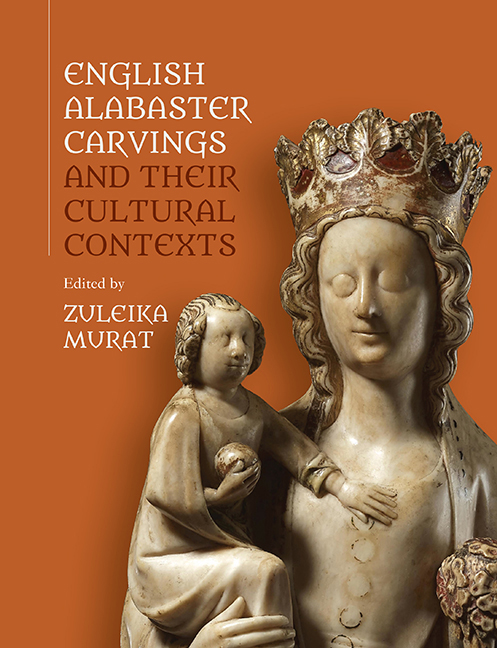Book contents
- Frontmatter
- CONTENTS
- List of Illustrations
- Acknowledgements
- List of Contributors
- Introduction
- 1 ‘Burton-Upon-Trent, Not Nottingham.’ the Evolving Study Of Medieval English Alabaster Sculpture
- 2 Stone to Ensure Victory and to Generate Friendships. On The Meaning of Alabaster
- 3 Contextualising English Alabasters in the Material Culture of the Medieval Mediterranean
- 4 English Alabaster Images As Recipients of Music in the Long Fifteenth Century: English Sacred Traditions in a European Perspective
- 5 Contextualising Alabasters in Their Immersive Environment. The ‘Ancona D'Allabastro Di Diverse Figure’ of the Novalesa Abbey: Meaning and Function
- 6 Alabaster Carvings in Late-Medieval Lincolnshire
- 7 ‘Tabernacles, Howsynges and Other Things’. Three Alabasters From the Burrell Collection in Context
- 8 Conservation Study of Three Alabaster Carvings From the Burrell Collection, Glasgow Museums
- 9 ‘Smooth as Monumental Alabaster’. the Alabaster Tomb Industry in England 1550–1660
- 10 Merchants’ Tombs in Alabaster
- 11 Exploring Alice: the Theological, Socio-Historical, and Anatomical Context of the De La Pole Cadaver Sculpture
- Bibliography
- Index
- Already Published
1 - ‘Burton-Upon-Trent, Not Nottingham.’ the Evolving Study Of Medieval English Alabaster Sculpture
Published online by Cambridge University Press: 14 September 2019
- Frontmatter
- CONTENTS
- List of Illustrations
- Acknowledgements
- List of Contributors
- Introduction
- 1 ‘Burton-Upon-Trent, Not Nottingham.’ the Evolving Study Of Medieval English Alabaster Sculpture
- 2 Stone to Ensure Victory and to Generate Friendships. On The Meaning of Alabaster
- 3 Contextualising English Alabasters in the Material Culture of the Medieval Mediterranean
- 4 English Alabaster Images As Recipients of Music in the Long Fifteenth Century: English Sacred Traditions in a European Perspective
- 5 Contextualising Alabasters in Their Immersive Environment. The ‘Ancona D'Allabastro Di Diverse Figure’ of the Novalesa Abbey: Meaning and Function
- 6 Alabaster Carvings in Late-Medieval Lincolnshire
- 7 ‘Tabernacles, Howsynges and Other Things’. Three Alabasters From the Burrell Collection in Context
- 8 Conservation Study of Three Alabaster Carvings From the Burrell Collection, Glasgow Museums
- 9 ‘Smooth as Monumental Alabaster’. the Alabaster Tomb Industry in England 1550–1660
- 10 Merchants’ Tombs in Alabaster
- 11 Exploring Alice: the Theological, Socio-Historical, and Anatomical Context of the De La Pole Cadaver Sculpture
- Bibliography
- Index
- Already Published
Summary
Some dragons are hard to slay. The persistence of the attribution to Nottingham sculptors of the English medieval religious carvings sculpted in alabaster is both perverse and puzzling, given the clear historical evidence that points to the contrary. Another misconception is that such alabasters are generally rectangular panels of mediocre artistic quality. In this chapter I hope to demonstrate how this distorted view of the subject has come about – nurtured in a stream of publications from around 1890 onwards – and to suggest further areas of historical research into this important artistic material.
The spurious trail of the ‘Nottingham alabaster panel’ was laid by three prolific and – it must be said at once – learned and scholarly writers: Sir William Henry St John Hope (1854–1919), Philip Nelson (1872–1953) and Walter Leo Hildburgh (1876–1955). Hope is the subject of a short and impersonal account in the Oxford Dictionary of National Biography, but neither Nelson nor Hildburgh achieved that form of immortality. I have, however, drawn on an account of Nelson by Pauline Rushton in Apollo in 2001 and one of Hildburgh by Catherine Oakes in the Journal of the History of Collections in 2006.
Hope was far and away the finest scholar of the three, entirely at ease in searching for, and making transcripts from, medieval archival materials. He was a heraldist of great distinction, whose writings in this field show that he had an independence and originality of mind, and he was an architectural historian of exceptional thoroughness. He was awarded his knighthood for his two-volume architectural history of Windsor Castle. He has been less highly lauded as an archaeologist of the below-ground, trench-digging sort, Mortimer Wheeler once commenting that he dug up sites rather as a farmer might dig up a field of potatoes, just to see what came up.
Hope's first contribution to the making of the alabaster-publications industry was a paper in Archaeologia in 1890, in which he linked up some of the dozens of extant carvings of the Head of St John the Baptist with documentary references to Heads of St John which he had found in late medieval wills and inventories.
- Type
- Chapter
- Information
- English Alabaster Carvings and their Cultural Contexts , pp. 35 - 50Publisher: Boydell & BrewerPrint publication year: 2019

